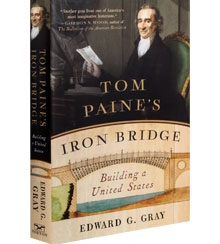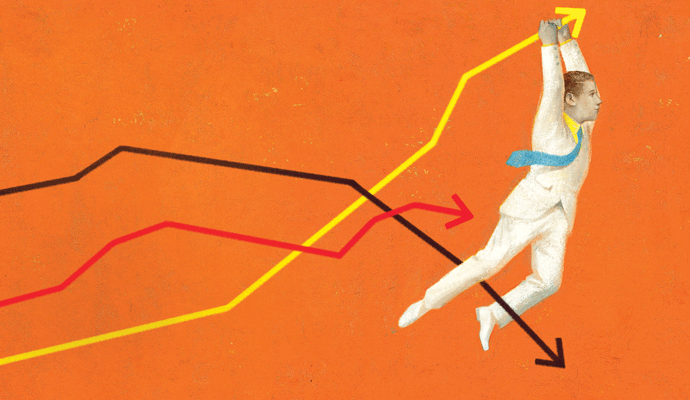Best Business Books 2016: Narratives
Turning Dreams into Reality
John Bloom
Eccentric Orbits: The Iridium Story. How a Single Man Saved the World’s Largest Satellite Constellation from Fiery Destruction (Atlantic Monthly Press, 2016)
Lloyd Handwerker and Gil Reavill
Famous Nathan: A Family Saga of Coney Island, the American Dream, and the Search for the Perfect Hot Dog (Flatiron Books, 2016)
* A TOP SHELF PICK
Edward G. Gray
Tom Paine’s Iron Bridge: Building a United States (W.W. Norton, 2016)
“Industry is a necessary but not sufficient quality for achievement,” Lloyd Handwerker writes in his lovely book about his grandfather, Famous Nathan: A Family Saga of Coney Island, the American Dream, and the Search for the Perfect Hot Dog. “An additional element is needed — something ineffable, random, and hard to pin down. Call it luck, or label it being in the right place at the right time.”
This year, the narratives among the best business books all explored that ineffable something that makes the difference between dreams that are realized and those that are broken — from the prosaic (Nathan Handwerker’s quest to build a thriving, exacting hot dog business) to the utilitarian (revolutionary pamphleteer Tom Paine’s plans for an iron bridge) to the literally cosmic (Iridium’s futuristic scheme for satellite phones).
The heftiest and the most complex of the books is the story of Iridium, the famous, and ultimately infamous, satellite telephone system started by Motorola in the early 1990s. In Eccentric Orbits: The Iridium Story. How a Single Man Saved the World’s Largest Satellite Constellation from Fiery Destruction, investigative journalist John Bloom writes that this big idea initially was seen as inevitable. The prospect of a network of satellites enabling phone calls from any point on Earth to any other was “a neon lightbulb moment, a realization that, yes, we’d been doing it all wrong, and surely the cell-phone future would belong to whoever owned the coolest satellites,” Bloom writes. And yet Iridium became a “$6.5 billion sinkhole” whose failure tarnished a once-mighty technology company. Those who believed in Iridium even got a nickname: Iridiots.
Those who believed in Iridium even got a nickname: Iridiots.
Eccentric Orbits is a story rich in larger-than-life characters, including shady Cold War operatives and warrior-like Motorola executives. The hero of Bloom’s book, Dan Colussy, the retired president of Pan Am, was a quieter sort who wasn’t even involved with Iridium at first. After Iridium’s bankruptcy in 1999, when Motorola was issuing threats to imminently “de-orbit” — i.e., destroy — the constellation of several dozen satellites, Colussy was almost alone in seeing value in what had been built. And so, starting in 2000, he embarked on an unlikely, but ultimately successful, quest to save Iridium. “Colussy’s main weapon became his deep soothing voice and his impenetrable calm in the midst of chaos,” Bloom writes. And, of course, his sheer refusal to admit defeat.
Bloom gives a wonderful sense of what an engineering marvel Iridium was. In terms of complexity, with its “sixty-six satellites, sailing around the planet in a geometrical canopy, blanketing Earth with sensors penetrating into the Amazon rain forest and the remotest parts of the oceans,” it has only one parallel in engineering history: the construction of the atomic bomb at Los Alamos. Bloom quotes one of the inventors telling the Wall Street Journal: “Iridium is God manifesting himself through us.”
Eccentric Orbits is also a history of the dreamers, writers, and politicians who envisioned and led the commercialization of space, and it is rich with anecdotes. Motorola’s de-orbit threats, a tension that drives the book, were finally (almost) put to rest just after Labor Day weekend in 2000, when a deputy secretary at the Pentagon told a Motorola executive to “tell Mr. Galvin [Motorola’s then-CEO] that if I hear one more f***ing threat to bring these satellites down, then his corporation is going to have a really hard time doing business with the Pentagon in the future.” There’s also the devastating moment when Iridium first opened for business on November 1, 1998, and eager executives checked to see how many calls were being placed: None. “What if a $6 billion company opened for business — and nobody came?” writes Bloom.
The story of Iridium makes you realize that if markets have any prayer of operating efficiently, they need people who see things differently. The people who showed up to buy Iridium out of bankruptcy were a slew of weirdos (whose qualifications or lack thereof are delightfully recounted by Bloom) — and Colussy, a conservative, self-made businessman who had risen to run Pan Am, but at 69 was planning on retirement and golf, not on running another company. Colussy’s total cash outlay was a mere US$6.5 million, which a journalist at the time compared to the steal that was the Louisiana Purchase. Slowly, slowly, slowly, under Colussy’s determined stewardship, Iridium won customers who saw its service as essential; these included disaster relief workers and Navy SEAL Team Six, which carried an Iridium phone into the house in Abbottabad, Pakistan, where Osama Bin Laden drew his last breath.
Bloom provides some answers to the question of why the original plan didn’t work. “Why isn’t everyone in the world walking around today with satellite phones in their hands instead of phones dependent on land-based cell towers?” he wonders. Well, Iridium’s original backers, including Motorola, gave up too soon. Iridium initially targeted affluent businesspeople who usually had other options, instead of targeting governments, relief workers, and others for whom a phone that worked absolutely everywhere would be indispensable. The phone was cumbersome and very expensive — $3,795 for the handset and about $4 a minute on average. And a cell phone’s ability to roam led to an explosion in land-based wireless phone service.
Almost Famous
At first blush, the process of making the perfect hot dog and serving it at top speed to an unending stampede of customers might seem a lot less complex than putting satellites in the sky. But the development of Nathan’s Famous “represented a complicated kind of choreographed ballet,” writes Lloyd Handwerker (and Gil Reavill) in Famous Nathan, whose details include the precise amount of water in the meat filling and the skills of a longtime employee who could serve 60 hot dogs a minute. Just as the flashes of the Iridium satellites light up the night sky, so did the signage of the Brooklyn-based hot dog stand illuminate the waterfront. “Viewed from the air, the former electric fantasyland of nighttime Coney Island became merely a dark smear upon the Brooklyn landscape, with only a single pinprick of light — Nathan’s Famous,” writes Handwerker.
Nathan Handwerker, who was born in Austrian-occupied Galicia, Poland, in 1892 and who emigrated to the U.S. in 1912, “was desperate to succeed,” his grandson writes in Famous Nathan. And succeed he did. During its heyday of the 1950s, the business grossed $3 million annually and was popular with such celebrities as Barbra Streisand and Frank Sinatra, both of whom ordered Nathan’s famous frankfurters flown over when they performed in London.
Much like Dan Colussy, Nathan Handwerker wouldn’t allow himself to fail. The stunning success of Nathan’s Famous was “the direct result of one man’s will to excel, to be ever watchful, to devote himself to the proposition that quality can be gained and maintained only by ceaseless, unflagging effort,” writes his grandson. “Compromise was the enemy. Laziness and the untoasted bun were sins.” Not incidentally, he was also a tough boss. “I don’t have heart attacks. I give heart attacks,” Nathan Handwerker once said, according to his son, Murray, who never forgot the line.
Nathan found a job on Coney Island just as it was becoming a destination for fun seekers. “By 1914, in his post cutting rolls and waiting tables at Feltman’s, Nathan was square in the middle of the action,” Handwerker writes. And then, in 1916, he found a storefront of his own that semi-miraculously turned out to be just a hundred feet from a new transit depot that was a point of debarkation for passengers from Brooklyn and Manhattan. As a result, the first thing the “huddled masses” saw was Nathan’s Famous.
This book is my favorite of this year’s crop because the simple story is elevated by the insight it offers into Nathan’s archetypal character, as well as by the rich historical context and lovely writing. We learn that Nathan Handwerker fought for every customer. He would hawk his hot dogs to anyone within earshot, and maybe some who shouldn’t have been. “You could hear me for twenty blocks,” he told one person. Handwerker writes that his grandfather would sometimes disguise himself so he could eavesdrop among the hordes of customers in “a personal sort of pre-Yelp Yelp.”
In addition, unlike the initial incarnation of Iridium, Nathan quickly got his price right. After the business struggled, he cut the price of his hot dog from a dime to a nickel. “The first weekend Nathan dropped the price of a hot dog, he more than quadrupled his business,” writes Handwerker. And whereas Motorolamade enemies with its arrogance and lack of finesse — Bloom writes that “Motorola was prepared to stampede, elephant-like, through the densest part of the jungle” — Nathan took care to make friends, among them all-important politicians. “He came to understand that in America as in Europe, good connections made for good business,” writes Handwerker.
Ultimately, Nathan’s Famous was reduced to far less than it could have been by the age-old problem of squabbling sons who were raised with privileges Nathan Handwerker himself never had. The company sold stock in 1968, and at its peak was worth almost $1 billion in today’s dollars, but high overhead, questionable expansion, and the decline of Coney Island as a tourist destination led to a brush with bankruptcy in the late 1980s. Today, the company, which is worth about $200 million, is probably best known for the annual Nathan’s Famous International Hot Dog Eating Contest. “Nathan tried to teach his sons what he knew,” a Nathan’s old-timer told Handwerker. “I’m sure that he saw some things they couldn’t learn no matter what college they went to.”
So perhaps it takes a kind of brilliance to have the big idea, and another kind of brilliance to make it work. “I don’t know how it came to me, so much common sense,” the founder is quoted as saying.
A Bridge Too Far
Common Sense, of course, is the name of the 1776 pamphlet for which Thomas Paine is remembered. In what could be a testament to the big dream, Paine wrote in Common Sense that “we have it in our power to begin the world over again.” Although Paine had the desire, ironically, he lacked common sense in how he conducted himself. Which helps explain why his other big dream — an iron bridge that would span the Schuylkill River at Philadelphia — came to naught in his lifetime. He died destitute and despised.
In Tom Paine’s Iron Bridge: Building a United States, Florida State University history professor Edward G. Gray attempts to rehabilitate a man who became known as something of a failure. “Like so many radical visionaries, Paine often seems more the man of ideas than of action, more the dreamer than the doer,” Gray writes. Certainly, Paine was better known for his radical politics, against which the tide of his time eventually turned, than for his architectural work.
But Gray “came to see that his political thought and his architecture were of a piece.” Paine was committed to the idea of free societies, and free societies “would work only insofar as their citizens could communicate with one another.” Thus, his idea of a bridge, which would “transform the Pennsylvania countryside and, ultimately, the whole of the United States from a welter of natural obstacles and commercial interruptions into a unified empire of liberty,” was in its time as grand as Iridium.
The eastern seaboard of the U.S., where the population was concentrated, was riven by streams, creeks, bays, and mighty rivers — which made commerce and communication incredibly difficult. And there wasn’t a perfect material for bridge construction. Stone was inflexible, and wood was breakable. But Paine realized that iron could be strong enough to withstand the assault of water, ice, and wind. Like putting satellites in the sky and maybe even like serving perfect hot dogs, building an iron bridge would take a near miracle of art, science, and execution. “Paine’s bridge was composed of hundreds of cast-iron bars fastened together to form a series of five parallel arches.... The structure loomed above the ground like a whale’s arched back situated between two wooden platforms,” writes Gray, who also notes that “in order to build a practical single-arch bridge,” Paine, who wasn’t an architect, “had to overturn centuries of architectural wisdom.”
Paine’s bridge design was counterintuitive, even revolutionary. Some of his peers got it. Paris’s Royal Academy declared in 1787 that Paine’s concept was “a design of supreme genius” with “an astonishing lightness and elegance of form.” And yet, although Paine’s design became the inspiration for other iron bridges in England and Spain, it was never built in the United States.
Why? Instead of making friends, Paine made enemies through his incendiary writing. He became an untouchable thanks to his support of the French Revolution. An ill-advised attack on George Washington didn’t help his cause. “Unlike so many of his equally well-known contemporaries, he never seemed to grasp the fundamental social truth of his age, namely that to gain the good graces of the powerful, it was necessary to flatter their sense of propriety and social superiority,” Gray writes. Eventually, his enemies made the situation such that “no serious promoter of public works dared acknowledge a debt to Paine.”
Gray writes that Paine “continued to believe that invention would triumph over politics and personal attack.” Perhaps a sorry lesson of these highly readable books is that it rarely does. Dan Colussy was able to save Iridium in part because he was smart enough to find government officials who were on his side; a U.S. government contract was a critical linchpin in launching Iridium out of bankruptcy.
But Paine, like the initial backers of Iridium, also got unlucky in the sense that there were readily available, if inferior, alternatives to his big dream. Iron may have been superior to wood, but Paine’s country had a lot of the latter. In the U.S., “the abundance of old-growth forests made the country no place for a builder of iron bridges,” writes Gray.
There are dreamers and doers. Sometimes, as in the case of Thomas Paine, dreamers can’t cross the bridge to becoming doers. Sometimes dreamers, like the initial backers of Iridium, fail because they assume everyone else will see the value of their idea, and it takes a doer to come in and align the stars. And sometimes, on the rare occasion when the dreamer is also a doer and common sense prevails, you can have your hot dog and eat it too. At least for one generation.
Reprint No. 16414
Author profile:
- Bethany McLean is a contributing editor at Vanity Fair. Her most recent book is Shaky Ground: The Strange Saga of the U.S. Mortgage Giants (Columbia Global Reports, 2015).








